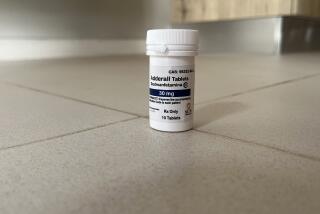Over-the-Counter Cold Medications Pose Latest Threat
- Share via
The winner of the 1904 Olympic marathon in St. Louis was Thomas Hicks, an English-born brass worker from Cambridge, Mass., who illustrated how modern medicine could enhance athletic performance.
Hick’s achievement, some suggest today, was bizarre, if not downright fraudulent.
With temperatures hovering in the 90s, Hicks took a 1 1/2-mile lead about 10 miles from the finish. But like some other competitors, he became overwhelmed by exhaustion.
Instead of resting him, doctors administered an oral concoction of strychnine sulfate mixed with raw egg white.
Hicks staggered onward.
A few miles later he began to struggle again. He drank more strychnine, this time mixed with brandy.
Each time he faded, Hicks was revived by another shot and eventually won by six minutes. Fortunately for him, the race wasn’t any longer than it was. He might well have died of strychnine poisoning.
Hicks’ is one of the more celebrated cases of victory aided by chemicals. But for as long as athletes have struggled to succeed, there have been experiments with artificial enhancements.
The latest drugs to surface on the track and field scene en masse are stimulants found innocently enough in over-the-counter cold medications.
Larry Myricks, Greg Foster and Antonio McKay were suspended for three months this year aftertesting positive for stimulants banned by the International Olympic Committee and International Amateur Athletic Federation (IAAF).
Still, track officials are not taking the problem seriously, according to Dr. Robert Voy, a sports medicine specialist in Las Vegas.
Although official and media attention have focused primarily on anabolic steroids, an equal number of U.S. athletes have tested positive for such stimulants as ephedrine, pseudoephedrine and phenylpropanolamine in recent years, Voy said.
Voy resigned as the U.S. Olympic Committee’s chief medical officer last summer partly because a feud developed when USOC leadership ignored growing misuse of stimulants, Voy said last weekend.
“I’m a much happier person, not being frustrated by the system that didn’t allow me to be forthright and accomplish what I wanted to,” he said.
Unlike steroids, the stimulants are used during competition. Athletes who take steroids do so to enhance their training and usually discontinue use by the time they compete.
But athletes needing an immediate boost might take a stimulant. Either that, or many are getting colds the day of meets.
Stimulants include various types of drugs that increase alertness, reduce fatigue and give athletes such as sprinters and jumpers sudden bursts of energy.
“Essentially, they are stimulating the system,” Voy said.
These drugs are known as look-alikes because they mimic the actions of amphetamines and, to some extent, cocaine. They are found in such household products as Nyquil Nighttime Cold Medicine, Alka-Seltzer Plus, Contac, Actifed, Chlorafed and Sudafed.
Ephedrine also is found in a Chinese herb called ma huang. The substance is used in vitamins and mineral preparations to give the consumer a quick lift, but otherwise has no redeeming value in a vitamin tablet, physicians said.
Stimulants are added to cough and cold medicines to counterbalance antihistamines, which cause drowsiness.
“Where maybe one dose of an Actifed won’t stimulate you, three or four tablets can act as a very good stimulant to the central nervous system,” Voy said.
“The problem that I have seen all along is the gradual increased use of these products because they’re easy to get and not considered illegal.”
Voy said one of the major debates in the sporting community is whether stimulants are as strong as amphetamines, cocaine or strychnine.
Dr. Manfred Donike, a West German pharmacologist serving on the IAAF’s medical commission, said doctors and administrators have problems differentiating between justified therapy and doping. He believes the problem will remain unresolved for two years.
The IAAF, which governs international track and field, stipulates that any positive test for a stimulant with fewer than 10 micrograms per milliliter is invalid. That was to protect athletes who took the drugs for medical purposes. Officials reasoned that such a low dosage would not enhance performance.
The Athletics Congress, the governing body for U.S. track and field, revised its rules last year to say that any positive test is valid. Officials wanted stricter rules for American athletes to help reduce the problem.
Donike, internationally known for advances in the testing of steroids, said the stimulant question is concentrated in the United States, Canada and Great Britain.
“It seems to be an Anglo-Saxon problem,” he said from Cologne, West Germany. “There seems to be an attitude problem there. Using over-the-counter medications is easy.”
Dr. Donald Catlin, director of the IOC’s drug laboratory at UCLA, said international use of stimulants has not changed much in the last two years.
Donike cited the International Cycling Federation’s work in eradicating the stimulant problem from its sport. For years, stimulant use in cycling was rampant.
Donike said education and strict enforcement have helped cycling officials overcome the problems, although the sport’s image remains tainted when the subject is drugs.
Stimulants have been used in other sports as well.
Bernie Parrish, formerly a defensive back with the Cleveland Browns, wrote about the first time he and a teammate took amphetamines in his 1972 book, “They Call It a Game.”
“We were wild-eyed and rowdy . . . Doctors say that (amphetamines) do not have any real effect on one’s performance, but we were convinced they were great. I never played another game in my college or professional career without taking either Dexedrine or Benzedrine.”
Whereas amphetamines and cocaine concern society, the drugs found in the cold medications do not command the same scrutiny.
“I don’t get terribly concerned about ephedrine,” said Dr. Bob Goldman, chairman of the Medical and Doping Committee for the International Federation of Bodybuilders. “You’d have to take a fair amount for it to work like speed.
“It also can be counter productive. Taking something like (cold medication) makes them a little sedated, so they’re almost at ground zero again.”
Voy understands the doubts in the medical community. He said medical literature does not support the theory that ephedrine works to enhance performance.
“But it was like when we first encountered steroids,” he said. “The literature said it wouldn’t work, but all the athletes wanted to know where they could get them.
“Pure scientific literature might not prove beyond a shadow of a doubt what the effects are and how they can enhance, but that doesn’t negate the fact an athlete can do better while on the drug.
“That can’t be scientifically investigated. There will be a big argument in the scientific community and they never will be able to prove it until they teach a laboratory rat to throw a javelin, or a dog to run 100 meters.”
Voy said athletes have told him they use the substances strictly for performance.
Voy said that one test revealed an athlete had an ephedrine level equivalent to four to eight ounces of cough syrup taken at once.
Catlin said studies from the 1950s show that amphetamines enhance performance for runners and swimmers. He also said the latest rumor is that stimulants interact with anabolic steroids for a better hormonal effect, but he has no evidence of that.
Last January, the NCAA removed ephedrine and its derivatives from its banned substance list, a move away from stopping the misuse, Voy said.
“Now you will see college athletes using this because they can get by with it,” Voy said.
More to Read
Go beyond the scoreboard
Get the latest on L.A.'s teams in the daily Sports Report newsletter.
You may occasionally receive promotional content from the Los Angeles Times.







